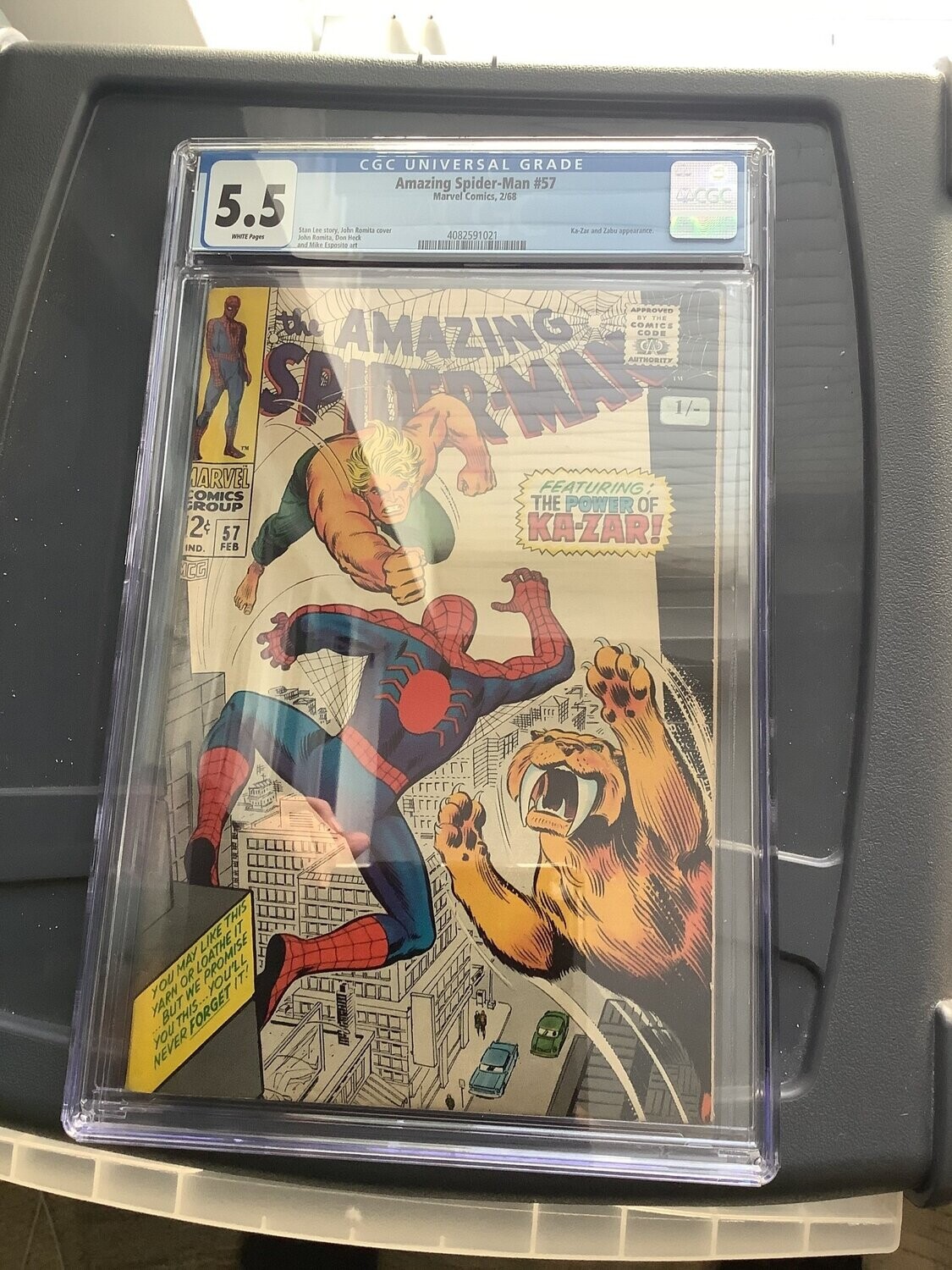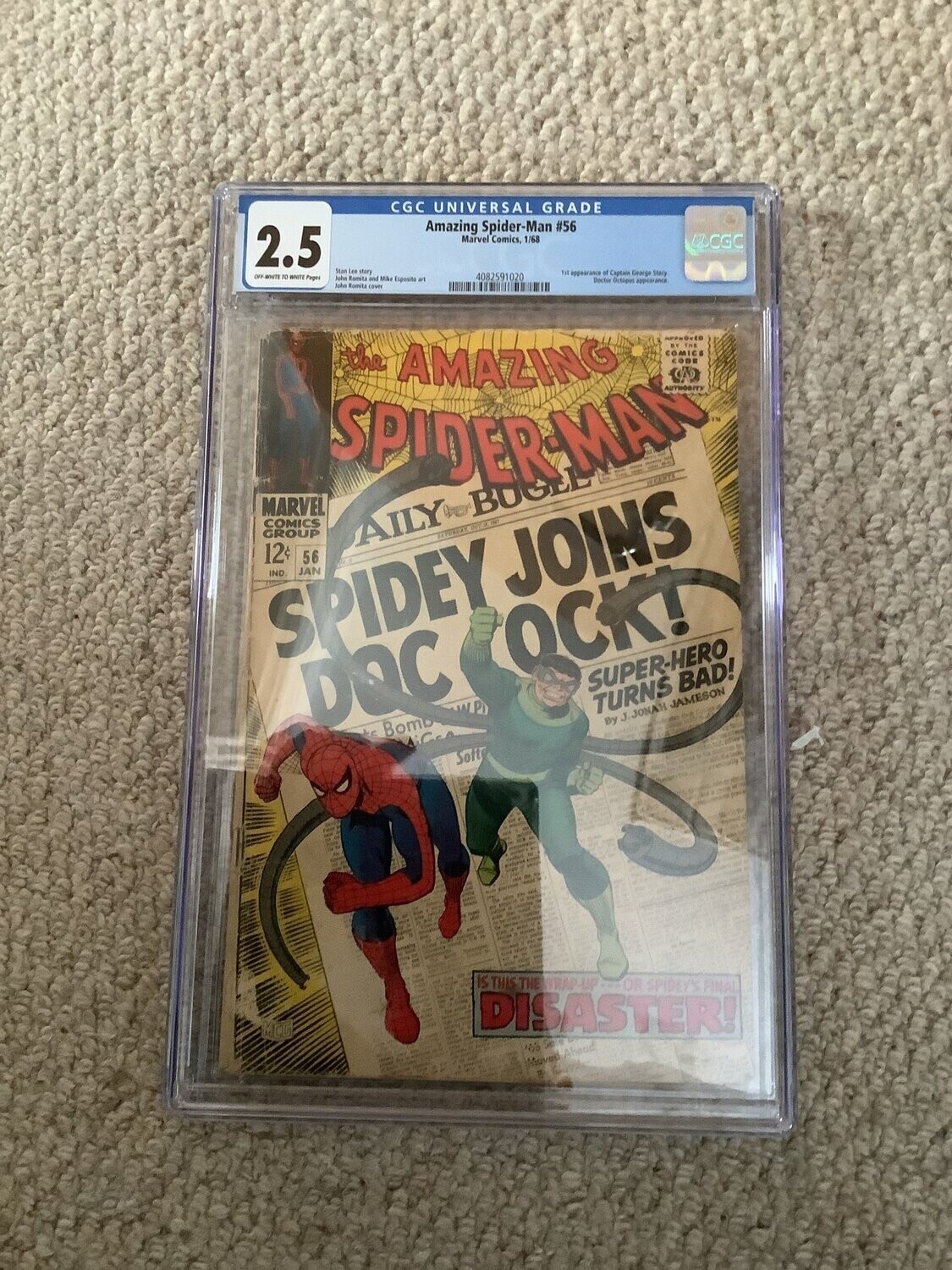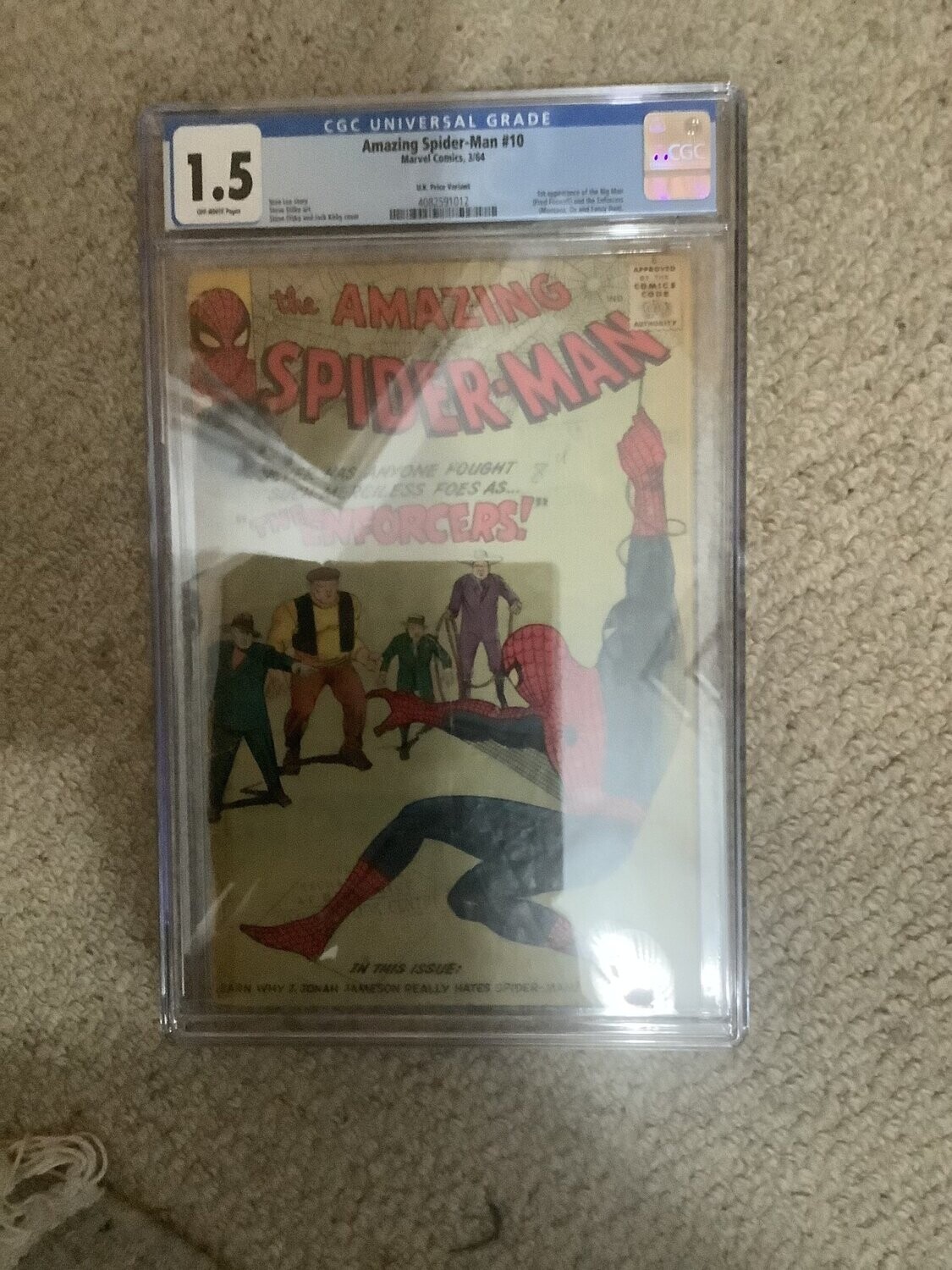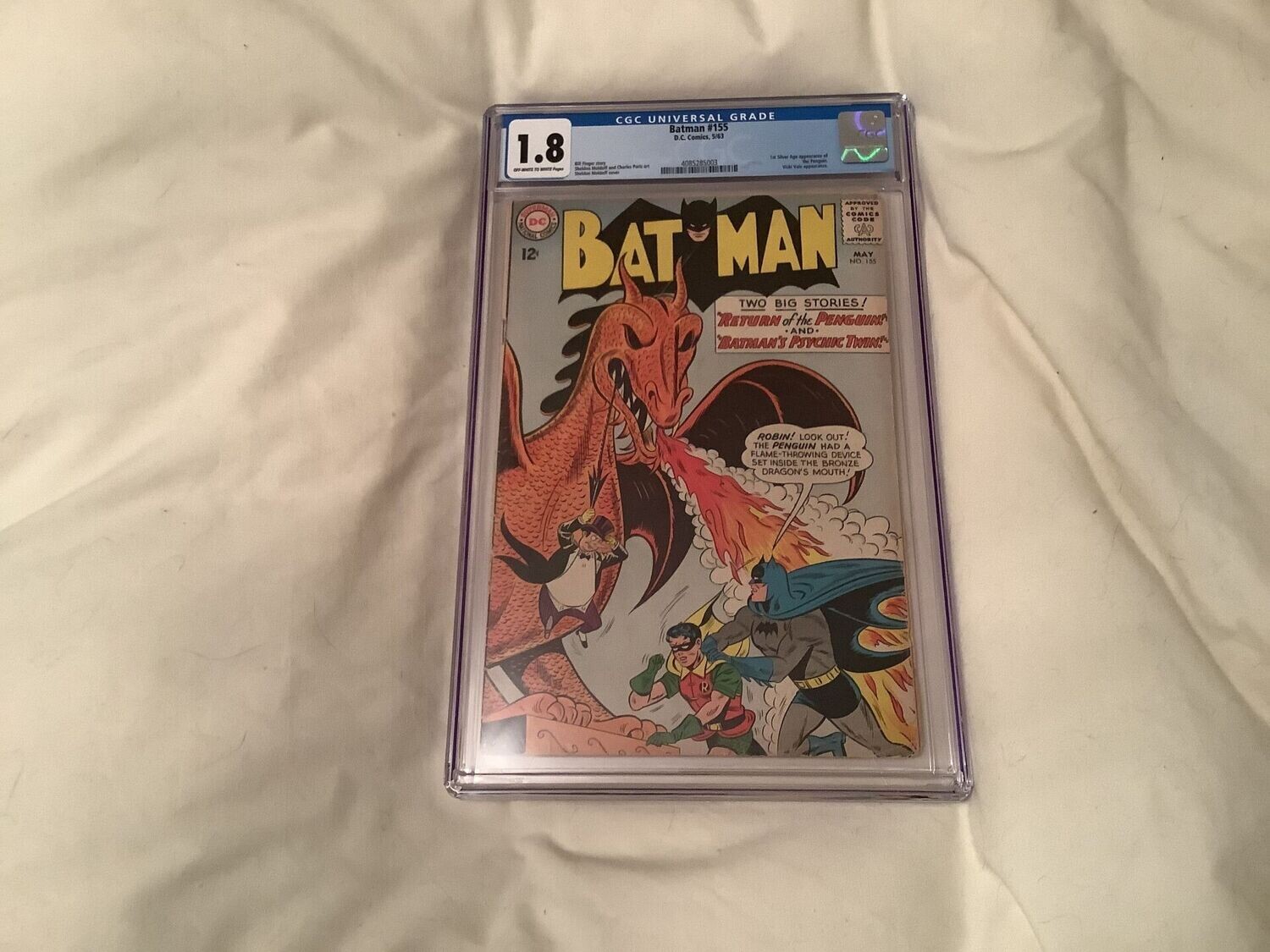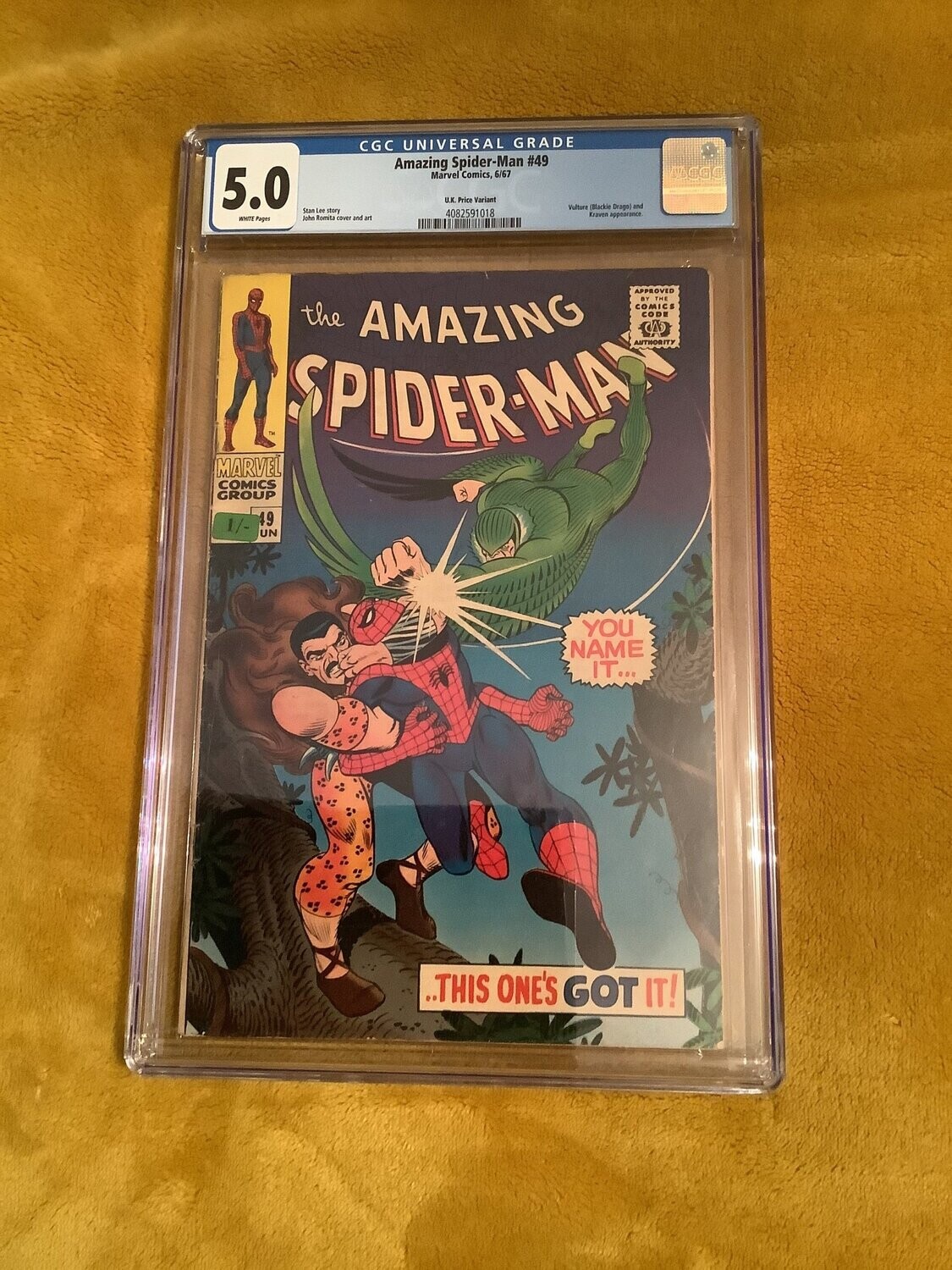The 7 Stages of
CGC Grading and Slabbing Comics
CGC -The Top Grading Service for Pop Culture Collectibles!
Certified Guaranty Company (CGC) is the world’s leading third-party grading service for Comic books, Trading cards, Magazines, Retro computer games, Concert posters and more.
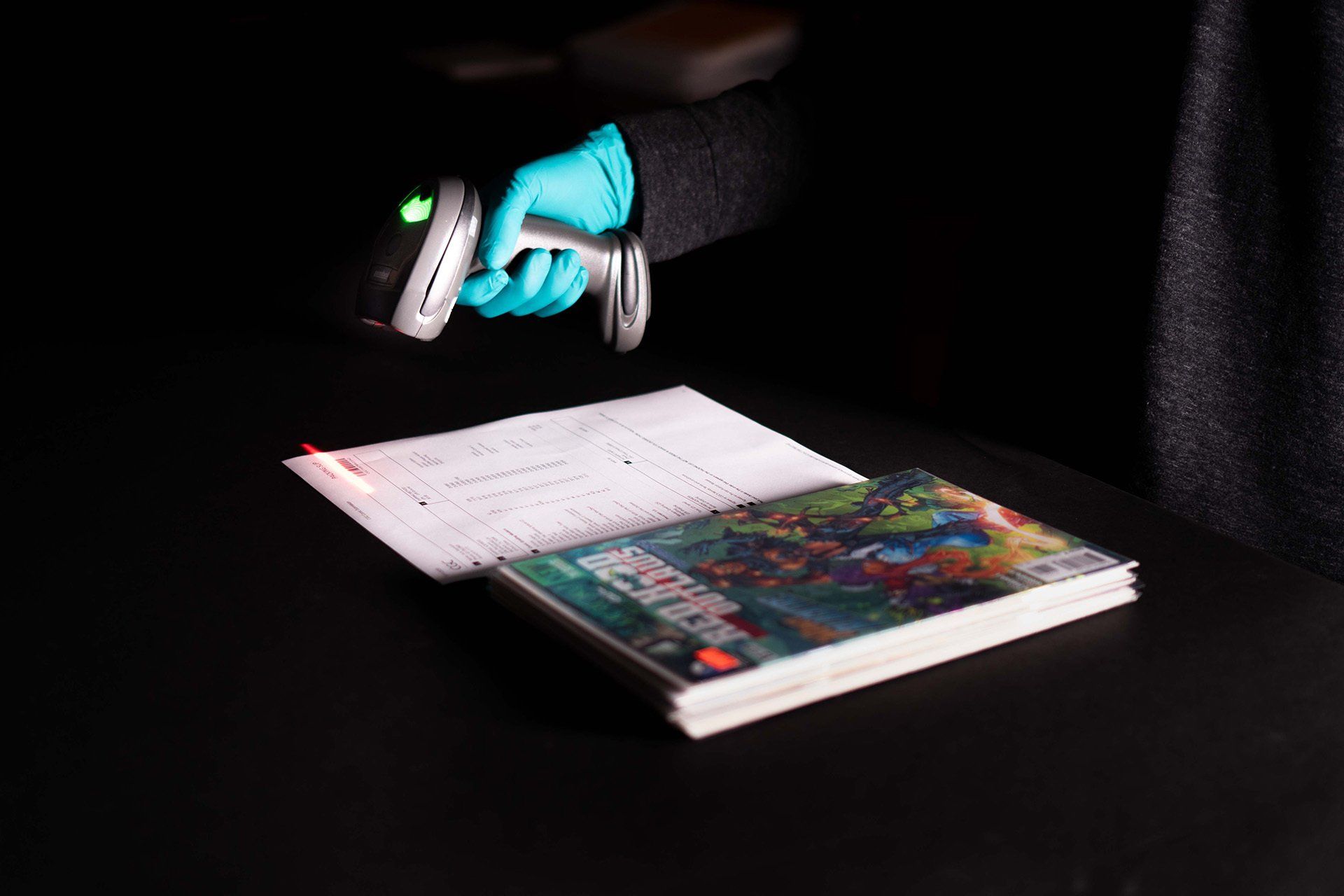
1 - Receiving
When a submission is received it is opened by trained staff under security camers and checked against submission paperwork. The submission is then entered onto the system and given a submission number
Submit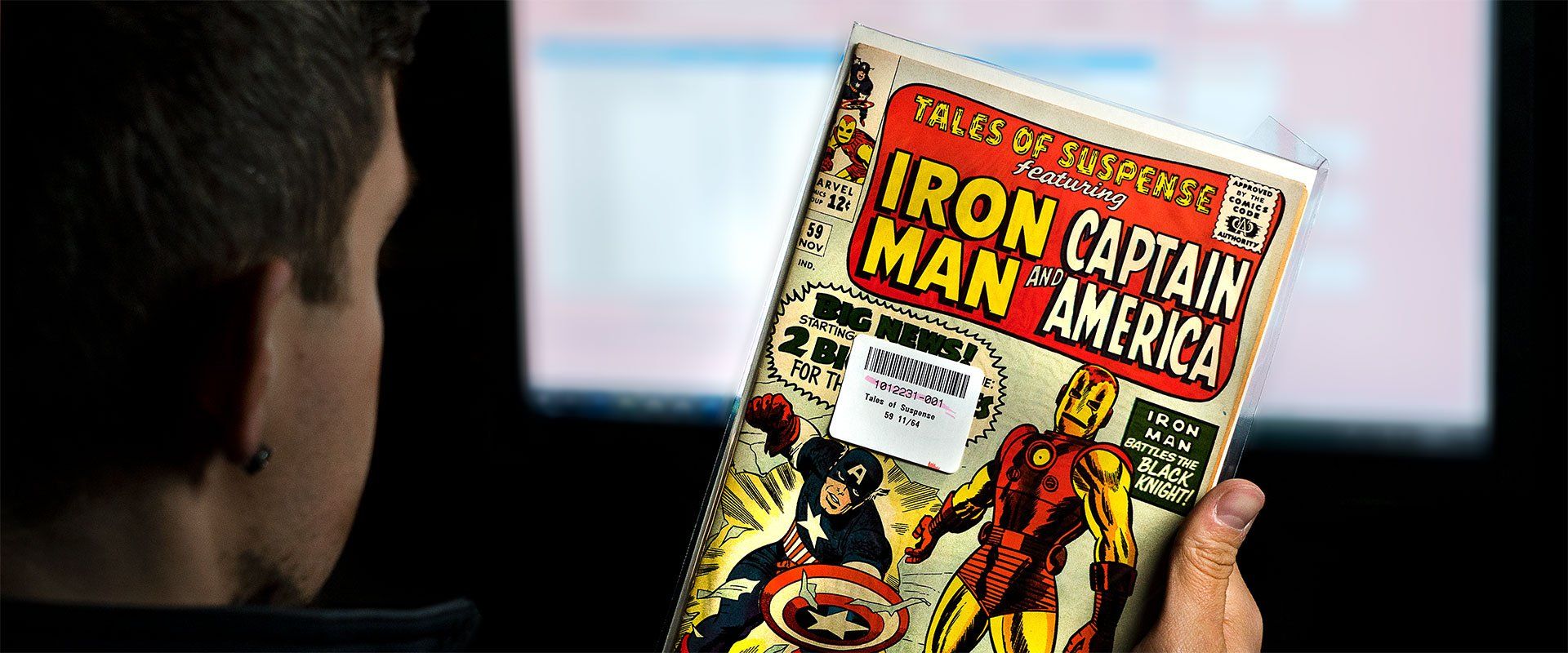
2 - Verification
Write your caption hereButton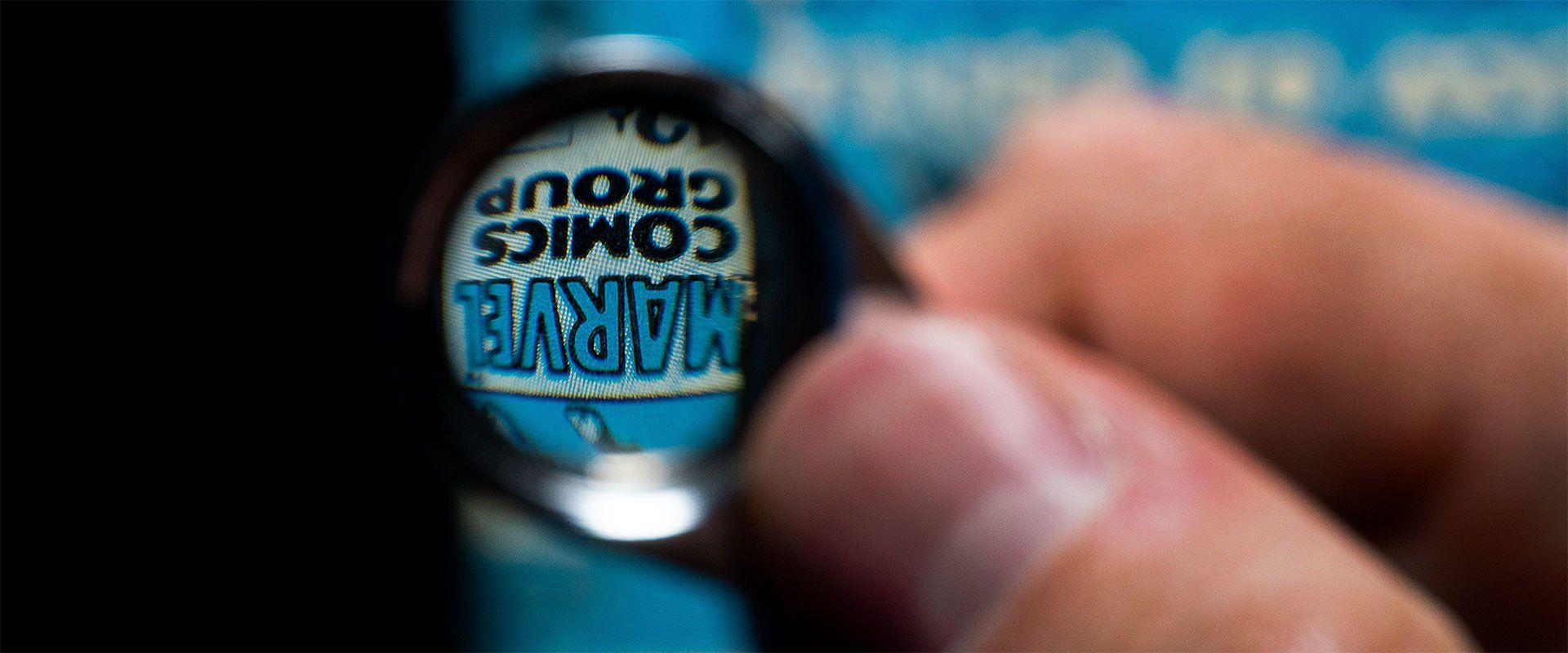
3 - Authentication
Write your caption hereButton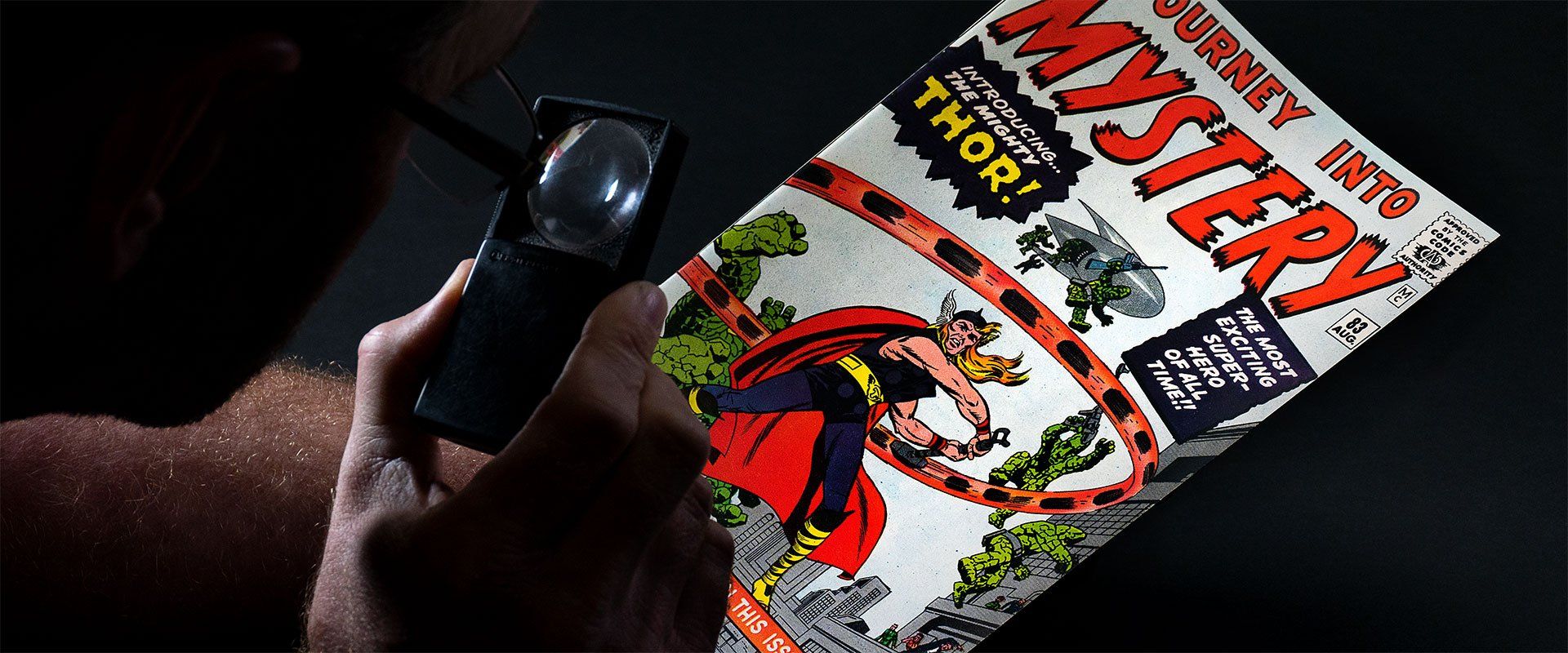
4 - Grading
Write your caption hereButton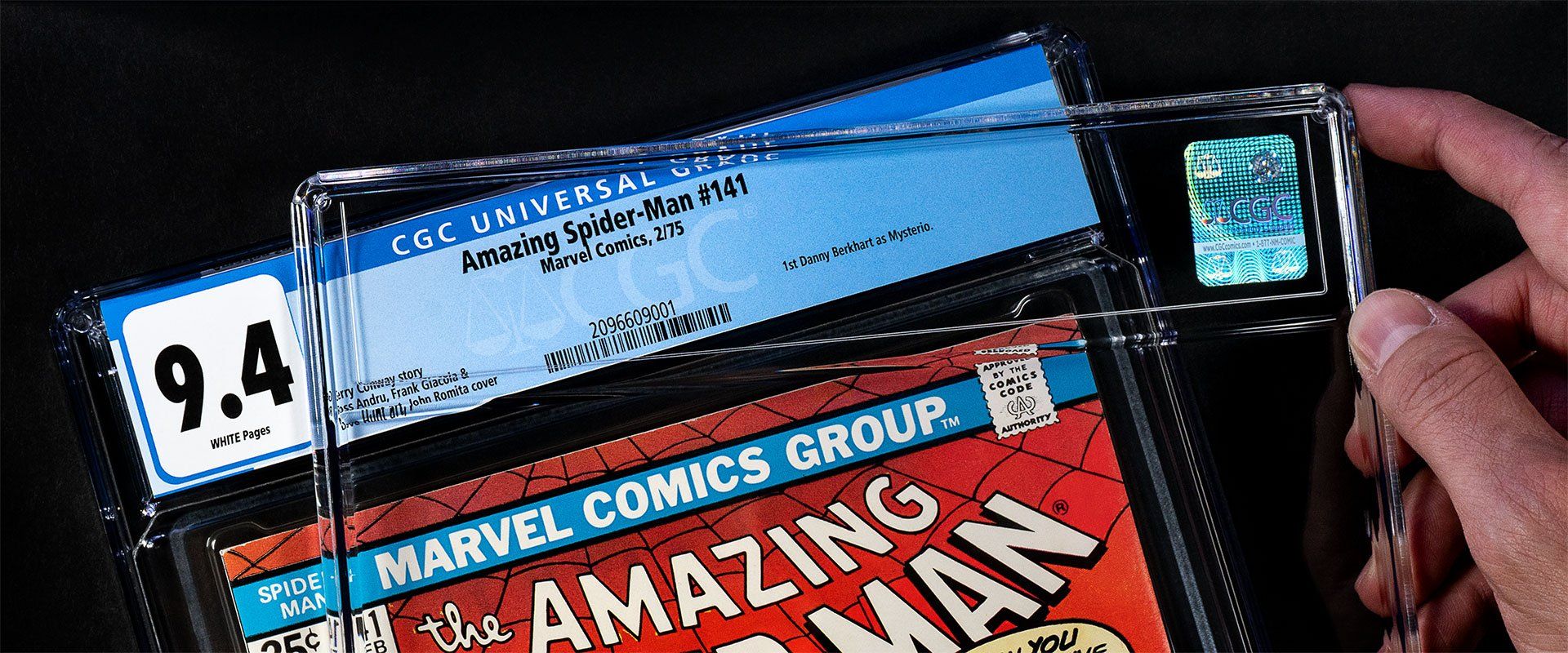
5 - Encapsulation
Write your caption hereButton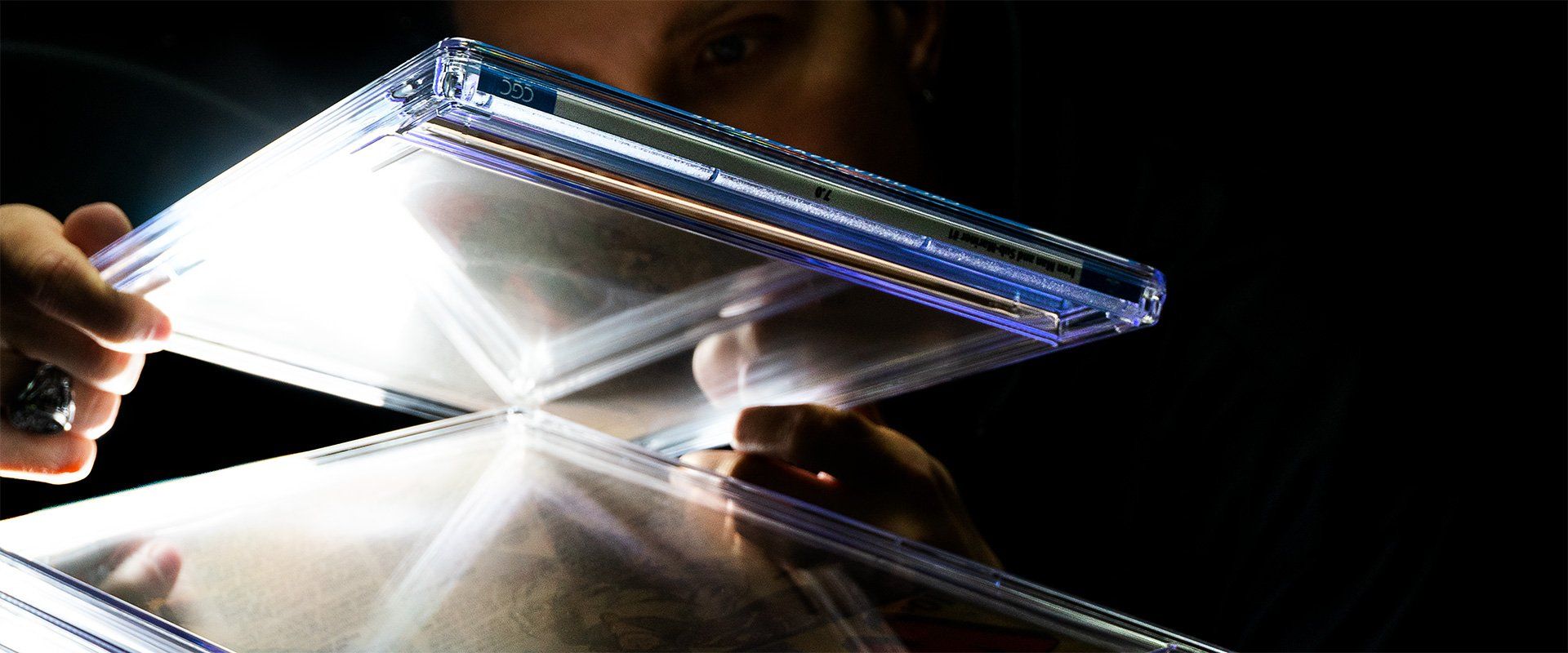
6 - Quality Control
Write your caption hereButton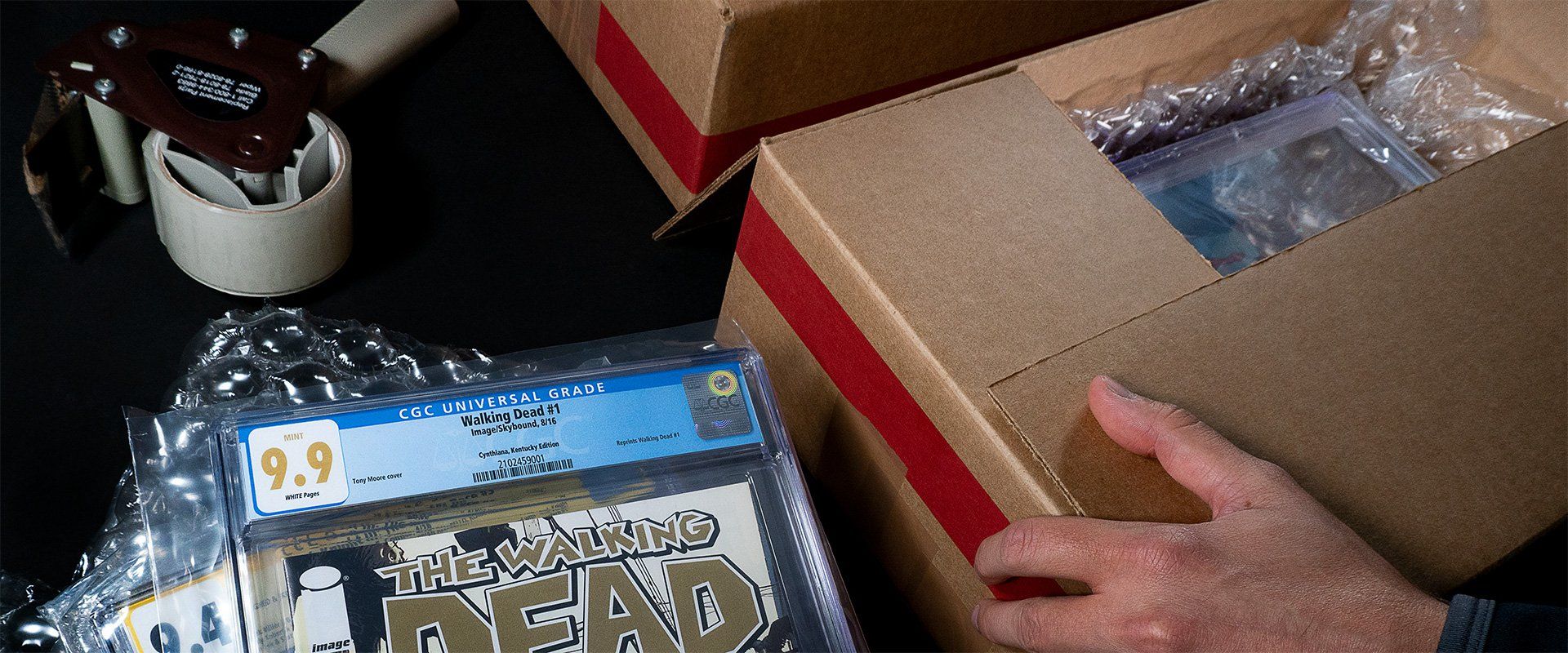
7 - Packaging and Shipping
Write your caption hereButton
CGC Comics and Magazines Grading Scale
Standard Grading Scale for CGC Comics
Gem Mint
10 The highest grade assigned. The collectible must have no evidence of any manufacturing or handling defects.
Mint
9.9 The collectible is nearly indistinguishable from a 10.0 but will have a very minor manufacturing defect. It will not have any evidence of handling defects.
NM/M
9.8 A nearly perfect collectible with negligible handling or manufacturing defects.
NM+
9.6 A very well-preserved collectible with several minor manufacturing or handling defects.
NM
9.4 A very well-preserved collectible with minor wear and small manufacturing or handling defects.
NM-
9.2 A very well-preserved collectible with some wear and small manufacturing or handling defects.
VF/NM
9.0 A very well-preserved collectible with good eye appeal. There will be a number of minor handling and/or manufacturing defects.
VF+
8.5 An attractive collectible with a moderate defect or a number of small defects.
VF
8.0 An attractive collectible with a moderate defect or an accumulation of small defects.
VF-
7.5 An above-average collectible with a moderate defect or an accumulation of small defects.
FN/VF
7.0 An above-average collectible with a major defect or an accumulation of small defects.
FN+
6.5 An above-average collectible with a major defect and some smaller defects, or a significant accumulation of small defects.
FN
6.0 A slightly above-average collectible with a major defect and some smaller defects, or a significant accumulation of small defects.
FN-
5.5 A slightly above-average collectible with several moderate defects.
VG/FN
5.0 An average collectible with several moderate defects.
VG+
4.5 A slightly below-average collectible with multiple moderate defects.
VG
4.0 A below-average collectible with multiple moderate defects.
VG-
3.5 A below-average collectible with several major defects or an accumulation of multiple moderate defects.
G/VG
3.0 A collectible that shows significant evidence of handling with several moderate-to-major defects.
G
2.5 A collectible that shows extensive evidence of handling with multiple moderate-to-major defects.
G
2.0 A collectible that shows extensive evidence of handling with numerous moderate-to-major defects.
G-
1.8 A collectible that shows extensive evidence of handling with numerous major defects.
Fa/G
1.5 A collectible that shows extensive evidence of handling with a heavy accumulation of major defects.
Fa
1.0 A very poorly handled collectible with a heavy accumulation of major defects.
Poor
0.5 A heavily defaced collectible with a number major defects. Some pieces will also be missing.
Page Quality Scale by CGC
White Paper that appears the same or very near the same as the day it was printed. Only the slightest traces of aging are allowed to a small area, such as the corner. Most comic books printed after 1990 exhibit white pages due to the discontinued use of pulp paper in printing comic books at that time. Only a white page designation is allowed in the 10.0 grade.
Off-White to White Paper that is still white, but exhibits very slight aging to the outer edges. A significant number of comic books from the mid ‘70s to late ‘80s exhibit this page quality. This designation is the lowest allowed in the 9.9 grade.
Off-White Paper that exhibits very light aging through the middle of each page, or white pages that exhibit light aging to the outer edges. With rare exception, comic books considered for the grade of 9.8 or better must achieve at least an off-white page designation.
Cream to Off-White Paper that appears white or off-white in the middle with aged outer edges, or exhibits an overall aged colour that is more close to brown than white. This page quality is most prevalent in comic books from the ‘30s, 40’s and ‘50s, but also includes a significant number of Silver Age comic books as well.
Cream Rarely given, this designation is for pages that are a uniform cream in colour from the edges to the middle of each page. Early Silver Age DC’s tend to exhibit cream pages more often than other comics from the same time period.
Light Tan to Off-White Paper that still appears off-white in the middle of each page, but the edges have developed a tanned appearance considerably darker than cream to off-white. This type of page quality is common among file copies, particularly from Dell and Harvey. A comic book cannot achieve a grade higher than 8.5 with this page quality.
Light Tan to Cream Similar to light tan to off-white, but the centre of each page exhibits a cream colour, while the edges are darker.
Light Tan Like cream pages, this category is for interior pages that exhibit a uniform colour edges to middle, but are slightly darker than cream.
Tan to Off-White Similar to light tan to off-white pages, but the edges of the pages are darker. The best grade a comic book can achieve with this page quality is 7.5.
Tan to Cream The same as tan to off-white, but the center of the pages are darker.
Tan Dark colored pages that exhibit a uniform tint from edges to middle.
Dark Tan to Off-White Pages that are very dark on the edges, but still retain off-white colour in the middle.
Dark Tan Pages that exhibit a very dark, uniform tint from edges to middle, but show no signs of brittleness.
Brown to Off-White Extremely dark pages that still exhibit off-white colour in the middle, and yet do not show signs of brittleness.
Brown to Tan Extremely dark pages with a slightly less dark tint to the middle of each page.
Brown Pages that exhibit a uniform colour of extreme darkness edges to middle, but do not show signs of brittleness.
Brown / Brittle Pages that are uniformly extremely dark, but are beginning to show slight signs of brittleness, such as corner chipping or edge tears that have formed from handling.
Brittle Designation
Slightly Brittle This grade refers more to the structural integrity of the interior paper than its colour. Slightly brittle pages exhibit slight splitting to top and bottom spine of interior pages or minor chipping to the corners. Both slightly brittle and brittle pages may not necessarily appear brown or tan in colour, particularly if the brittleness is relegated to only one edge or corner of a comic book. The highest grade achievable with a slightly brittle page designation is 6.5.
Brittle This page designation refers strictly to the compromised structural integrity of the interior paper, which exhibits either heavy multiple spine splits, corner and edge chipping, or both. In some cases pages can appear off-white or white, but suffer from an isolated area of brittleness along the spine that has caused heavy splitting. Brittle pages are sometimes impossible to restore because of their fragile nature. The highest grade allowed for brittle interior pages is 3.5.
Pink and Blue Pages
Pink This page designation is given to a small number of Golden Age comic books that were printed with pink tinted paper, particularly late ‘40s comics published by Fox. Pink is essentially equal to white in this instance.
Cream to Pink These pages exhibit the same aging as cream to off-white, showing tanning along the edges with a clean pink tint in the middle. Ascertaining the page quality of pink pages is more difficult due to the lack of contrast between the colour pink and brown, as compared to white and brown.
Tan to Pink This designation is similar to cream to pink pages, but the edges are considerably darker.
Blue Similar to pink pages, this grade is given in those rare instances when comic books were printed on blue tinted paper. Fox publications also occasionally used blue paper when printing their comic books in the late ‘40s.
Restoration Grading Scale by CGC
CGC’s Restoration Grading Scale is a transparent system that is much more descriptive and accurate than before. Every type of restoration found on each book will be individually graded for quantity and quality, with a cumulative score determining the final restoration grade assigned.
Quality (Aesthetic) Scale
Determined by materials used and visual quality of work
A (Excellent) - Material used: rice paper, wheat paste, acrylic or water colour, leaf casting
- Colour match near perfect, no bleed through
B (Fine) - Material used: pencil, crayon, chalk, re-glossing agent, piece fill from cadavers
- Piece fill obvious upon close inspection, obvious to the touch
C (Poor) - Material used: glue, pen, marker, white out, white paper to fill missing pieces
- Piece fill obvious at arm’s length
Quantity Scale
Determined primarily by extent of piece fill and colour touch
1 (Slight) All conservation work, re-glossing, interior lightening, piece fill no more than size of two bindery chips, light color touch in small areas like spine stress, corner crease or bindery chip fill. Married cover or interior pages/wraps (if other work is present)
2 (Slight/Moderate) Piece fill up to the ½” x ½” and/or colour touch covering up to 1” x 1”. Interior piece fill up to 1” x 1”
3 (Moderate) Piece fill up to the size of 1” x 1” and/or colour touch covering up to 2” x 2”. Interior piece fill up to 2” x 2”
4 (Moderate/Extensive) Piece fill up to the size of 2” x 2” and/or colour touch covering up to 4” x 4”. Interior piece fill up to 4” x 4”
5 (Extensive) Any piece fill over 2” x 2” and/or colour touch over 4” x 4”. Recreated interior pages or cover
Grading Guide (What do VG FN VFN NM mean?) - Standard Grading Scale
Here is a brief guide to some of the terms used when grading a comic. Most of our stock is BRAND NEW. These grading terms are only used on second hand stock, and will appear alongside the issue number. If no grade is shown, you can assume stock is BRAND NEW.
(Please note that BRAND NEW does not mean 'perfect' - even new comics suffer from minor defects as part of the rigours of handling - from the printers - to the distributors - to the retailer - to you. We won't send you a mashed up copy 'as new', but likewise, we cannot guarantee that every copy is perfect, and untouched by human hands! If you need to check that your comic is absolutely perfect, and can't bear even microscopic signs of handling, then buying by mail order is not for you - best trek down to your local comic shop, and deal face-to-face)
NM (Near Mint)
As new. No discernable faults. To all intents and purposes a brand new copy. What distinguishes Near Mint from Mint is that Mint is supposed to represent perfection. As most uncirculated copies are rarely 'perfect', the term Mint is rarely used (or should be viewed with caution).
VFN (Very Fine)
An 'as new' copy, with minor defects (a very small spine crease, or a very slight dink on the corner). Should have strong 'eye appeal' - with any fault hardly noticeable without close inspection.
FN (Fine)
A nice collectable copy, that may show a few signs of wear. At arms length it should look nearly new, but on closer inspection, you may spot small faults - a small light crease, a few spine creases, a small stain, interior pages not perfect white (light browning at the edges OK - heavy browning not OK in this grade). Should still look nice, but not perfect.
VG (Very Good)
An average 'used' copy. Still complete in every way, but has more obvious faults. A small tear. A heavier crease or two on the cover. Multiple spine creases OK. Pages may be off white/slightly brown, but not heavily brown. May have some wrinkling (water damage) on one edge. A decent reading copy, but clearly not new, but also, not a total mess.
G (Good)
A pretty poor copy. Complete with all pages, but may have multiple faults, small chunks missing (but not affecting story), noticebaly brown pages.
Mid-Grades (VG/FN etc)
VG/FN simply means the grade is somewhere between VG and FN
-
The Amazing Spiderman 28 Key IssueCGC 2.5 1965
SKU 00000£250Buy Now -
The Amazing Spider-Man No 55 CGC 3.0 1967
SKU 00001£150Buy Now -
Prince Namor the Sub-Mariner No 14 CGC 3.5 1969
SKU 00002£49Buy Now -
The Avengers 18 CGC 3.0 1965 Comic
SKU 00003£90Buy Now -
Amazing Spider-Man 28 CGC 1.0 Key Issue Comic
SKU 00007£99Buy Now -
The CGC Comic Shop Gift Card
SKU 00004£50Buy Now -
Amazing Spider-Man # 24 CGC 1.8 1963 Comic
SKU 00086£79Buy Now -
Amazing Spider-Man # 57 CGC 5.5 1968 Comic
SKU 00093£149Buy Now -
Amazing Spider-Man # 56 CGC 2.5 1967 Comic
SKU 00094£149Buy Now -
Amazing Spider-Man # 30 CGC 2.0 Comic
SKU 00099£89Buy Now -
Fantastic Four # 55 1966 CGC 1.0 COMIC
SKU 00100£129Buy Now -
Amazing Spider-Man # 10 CGC 1.5 1963 Comic
SKU 00105£249Buy Now -
Batman # 155 CGC 1.8 1963 Comic
SKU 00112£215Buy Now -
Amazing Spider-Man # 49 CGC 5.0 Comic
SKU 00114£229Buy Now
Superior Preservation and Security - The CGC Holder
The holder’s sturdy outer plastic better resists impacts. The holder design uses precise pressure to lock the comic in place for enhanced protection, and the hologram affirming authenticity is now hot-stamped and embedded into the plastic for improved protection and increased security.
Faster Turnaround
The CGC holder and label are easy to apply in fewer steps, which streamlines the entire encapsulation process. The simplicity and speed of the process help the CGC team turn books around faster with even less handling.
Collection Integration
Comics of nearly any size fit in the CGC holder. The CGC holder also locks and stacks with other CGC holders, both old and new, making the new holder easy to integrate with your existing collection, and creating a uniform display you can be proud of.
Certified Guaranty Company® (CGC®) revolutionized the comic book marketplace when it was founded in 2000 by providing clear, objective and impartial assessments of authenticity and grade. Today, CGC is the world's largest and most trusted third-party grading service for comics, trading cards, magazines, concert posters and related collectibles with more than 6 million collectibles certified since 2000.
Benefits of Grading
Confidence is knowing what you're getting.
Certification offers many benefits for comic book collectors, dealers and retailers. As an independent grader, impartial to any party, CGC provides this certification with accuracy and enthusiasm
A Market Standard
CGC's top graders traveled the country to survey leading comic book collectors, retailers and dealers for their opinions of a "grading set" of comic books. Using the average of their opinions as a guide, our team established a consistent, trusted market standard for comic book grading.
Expert Analysis
Professional comic book grading provides expert assessment of condition and eliminates concerns about grade misrepresentation. Before a comic book is CGC-certified, it must be graded by at least two comic professionals according to well established standards that ensure integrity, quality, confidentiality and consistency.
Restoration Check
The CGC grading team performs a thorough restoration check of your comic book during the grading process. Any detected restoration is specifically noted on the grading label. We include this service in your submission price.
State-of-the-Art Protection
The CGC holder uses the most cutting-edge technology to provide the best protection for your comic books. Durable and tamper-evident, the holder is slim and lightweight, making it easy for collectors to store and transport their books. The label displays comprehensive information about the book and its grade, and the holder provides clear viewing from the outside as well as a safe opening mechanism for access to the book. Note that removal from the CGC holder voids the certification.
Confident Buyers and Sellers
With a consistent standard, impartial grading, expert restoration detection and a tamper-evident protective holder, you know what to expect from a CGC-graded book. Buyers and sellers can trade with confidence by mail, phone or over the Internet. Impartial and accurately graded comic books allow buyers to be confident, and aggressive bidders and sellers can rest assured that they're getting a fair price for a book's condition.
Pros of Slabbed Comics:
- Consistency of Grades-Slabbed comics provide a consistency in grading and price that did not exist prior to slabs being invented.
- Value- The price of slabbed comics is substantially higher for most books, creating more value for the owner.
- Protection- The CGC, PGX, and CBCS cases provide great protection for a book. You can drop it and it probably won’t hurt the comic.
- Expanded Market- Slabs broaden the market by 100,000’s buyers and sellers. This, in turn, allows the turnover of comics easily and prices to continue to rise as demand is protected as long as comics are seen as a safe bet.
- Display- Quite simply the books display as professional works of art, not just a comic book.
Submit your Comics
Click Submit your Comics which will take you to our CGC Submission page
What Do the Different CGC Label Colours Mean?
Blue — When the label colour is blue, it means that CGC has determined the comic has not been altered in any way from its original state. It is considered unrestored.
Green — When the label colour is green, CGC has determined that the comic has a hidden defect or an unverified signature that qualifies the grade that it would have been had the defect not been there. For instance, if a coupon has been cut out of the interior of the comic, but it otherwise would have been an FN 6.0, CGC would grade the comic a Green Label FN 6.0 and notate the missing coupon on the label itself.
Purple — When the label colour is purple, it means that CGC has found the comic has had some sort of amateur or professional alteration done to the comic book. Collectors have nicknamed this label a PLOD, which stands for Purple Label of Dxxxx Usually, PLODs sell for 10-30% of the price of their Blue-label counterparts.
Yellow — When the label colour is yellow, it means that a representative of CGC has physically witnessed a signature by the signer. CGC has designated a yellow label to be a “Signature Series” comic. Thus, when collectors refer to Signature Series in print, usually they will write SS for short.
Principles of Self Grading
A GUIDE TO GRADING by The CGC Comic shop
The most difficult, contentious and eternally frustrating aspect of comic collecting is grading. For collector and dealer alike, it is essential to grade the condition of a comic fairly and accurately in order to determine its true value and worth.
Collectors in today's market seem to be more discerning and more knowledgeable, so accuracy on the higher mid grades and high grades becomes more important.
As grading is very much a subjective exercise, it is all too easy for the novice (and indeed experienced collector) to allow wishful thinking and optimism to influence the appearance of a comic and make it better than it really is.
It is always worth re-evaluating your own grading criteria from time to time in order to become the more expert. Accurate and consistent grading only comes with experience.
A useful exercise for any collector is to lay out one example of each of the main grades side by side for a direct comparison.
Where possible, The Guide will show illustrations of the same comic in different grades. This will be a slow process but you will find some examples in the database.
THE PROCESS OF GRADING
These principles can apply to both American and British comics.
1. Open the comic carefully and grade from the inside out. Lay it on a flat surface or hold it in the cup of the hand. Do not bend back or flatten out the comic.
Check that there is a centrefold and that it is attached by both staples. Check for missing pages, panels or coupons that may have been cut out. Check for tears in pages, writing, scribbling or any kind of water or ink stains. Check outer edges of pages for any signs of browning or brittleness. One may check the smell of the comic for any hints of acidity or dampness.
2. Check inside front and back covers, particularly opening the cover page to see how it strains against the staples which may have resulted in a slight tear at the staple. Check that the cover hasn't become detached at the top or bottom staple.
Older UK comics tend not to use stainless steel staples so rust is more prevalent. Rust can be so bad that the staples are practically disintegrating. This is particularly prevalent with British comics from the 1950s and early/mid 1960s.
Check for any unusual whiteness compared with the page colour as this may indicate cover-bleaching or stain removal. Check for any staple re-inforcement.
3. Check back cover for any tears and/or pieces out. Check for any wear or soiling along the back cover spine.
4. Check the front cover. This is the most important part of the comic as it is most seen when displayed and liable to the most wear or defacement. The areas of most common wear are around the staples/spine area and at the corners. Check for any cracks or chipping along the right-hand edge (more applicable to American comics than British). Hold the comic up to the light and check the depth of colour, the amount of cover gloss (more American comics) and any indentations. Check dark blue and black areas for any signs of colour-touch (more applicable to American comics than British).
5. Finally, assess the overall appearance of the comic, checking for tightness and squareness of trim. Many comics were mis-cut or had off-centre staples as part of the initial production process. American comics in particular can suffer from cover wraparound where some of the back cover is visible from the front, sometimes called white line or 'white spine'. On British comics look out for 'foxing'. These are orange/red spots that appear mostly on covers, sometimes quite light, other times quite heavy and very noticeable. These spots are spores in the paper, usually caused by storage in damp conditions. It can really spoil the 'eye-appeal' of a comic. Something else to watch out for - both US and UK comics can have 'dust shadows' across their covers. This is where a pile of comics has been exposed to some sunlight or accumulated a layer of dust. A line is left where one comic was lying across another one.
Glossary of Grading Terms
Bend
When part of a comic is curved, interrupting the flat, smooth cover surface. Bends WILL NOT show distinct lines (see also crease/fold).
Bindery Tear
A small horizontal rip in a comic's cover that can usually be seen on both the front and the back. These are always found along the spine and should be graded like spine stress if they are shorter than 1/4".
Chew
Damage caused by the gnawing of rodents or insects (usually). Results in multi-page paper loss with jagged edges. Very visually distinct.
Cockling
Bubbling on a cover's surface (typically a printing defect).
Crease
A fold that causes ink removal/color break, usually resulting in a white line (see bend/fold).
Denting
Indentations or dimpling (usually in the cover) that don't penetrate the paper or remove any gloss, but do interrupt the smooth, flat surface.
Double Cover
Technically a printing defect, double-cover books had an extra copy of the cover stapled on during manufacturing. This protective extra cover can be a boon, as these books are graded by the condition of the innermost cover.
Dust Shadow
When a comic has been stored in a stack at some point in its life, any portions of the cover that weren't covered up by the adjacent books have been exposed to environmental air, light, and settling dust particles, sometimes creating lines of discoloration along the edges.
Fingerprints
When finger oils left behind from everyday handling remain on a comic's surface, they can begin to eat away at the ink, literally creating color-breaking fingerprints on the cover that are sometimes distinct and sometimes smudged. Finger oils can usually be wiped away, but fingerprints are irreversible.
Flash
A method of examining a comic that uses its natural gloss and light (glare) to help you see imperfections in its surface, like denting.
Fold
Linear dents in paper that have distinct lines, but DO NOT break color (see also bend/crease).
Foxing
Bacterial or fungal growth in the paper of a comic (usually the cover) that presents in brownish discolored clusters or spots.
Gloss
The shiny surface finish of a comic.
Moisture/Water Damage
The damage left behind when a comic has been exposed to moisture (directly or environmentally). Water damage often presents with staining and/or a stiff or swollen feel to the paper. Look for lines of demarcation.
Paper Loss
When the surface of a comic has been compromised. This can be the result of heavy scuffing/abrasion, accidental tape pull, or the chemical reactions caused by some kinds of moisture damage.
Paper Quality
Paper quality refers to the coloration and structural integrity of a comic's cover and interior pages. We do give some leeway on pre-1980s comics, but when environmental conditions have caused the paper to oxidize and/or deteriorate significantly, the decrease in eye appeal and paper strength will bring a book's grade down. Generally, paper quality will not be a concern for most modern (post-1980) comics.
Printing Defect
A flaw caused in the printing process. Examples: paper wrinkling, mis-cut edges, mis-folded or mis-wrapped spine, untrimmed pages/corners, off-registered color, color artifacts, off-centered trimming, mis-folded or unbound pages, missing staples.
Reading Crease
A vertical cover crease near the staples that runs (generally) parallel to the spine, caused by bending the cover over the staples or just too far to the left. Squarebound books get these very easily.
Restoration
Any attempt (professional or amateur) to enhance the appearance of an aging or damaged comic book. Dry pressing/cleaning and the simple addition of tape repairs are not considered restoration, but the following techniques are: recoloring/color touch, adding missing paper, stain/ink/dirt/tape removal, whitening, chemical pressing, staple replacement, trimming, re- glossing, married pages, etc. Restored comics generally carry lower value than their unaltered counterparts.
Scuffing
A light paper abrasion that may or may not break color, but interrupts the surface gloss of the book. Its effect on grading is determined by severity.
Soiling
Substances or residue on the surface of a comic. Most commonly found in white spaces. Residue is a more severe form of soiling.
Spine Break
A spine stress that has devolved into a tear (usually through multiple wraps). Spine breaks greatly decrease the spine's structural integrity and are often found close to the staples.
Spine Roll
A condition where the left edge of a comic curves toward the front or back, caused by folding back each page as the comic was read. Also usually results in page fanning.
Spine Split
A clean, even separation at the spine fold, commonly above or below the staple, but can occur anywhere along the spine length.
Spine Stress
A small crimp/fold perpendicular to the spine, usually less than 1/4" long.
Staple Detached
When a wrap has come completely loose from a staple and is no longer bound to the comic in that area.
Staple Migration
When staple rust has moved onto the surrounding paper, causing staining.
Staple Popped
When one side of a cover has torn right next to the staple, but is still attached by the slip of paper beneath the staple. If not handled carefully, a popped staple can lead to a detached staple.
Staple Rust
Literally, rust on the staple.
Subscription Crease
A vertical cover-to-cover fold caused by the book being folded in half when sent through the mail directly from the publisher.
Wrap
A single sheet of paper folded to form four pages of a story. Most modern comics have eight wraps, plus the cover (but there are exceptions!).
Writing
Writing can be found on/in comics in many forms, and downgrades are based on severity. Common things you'll see:
- Minor initial or date markings (do not affect grade except in the highest range)
- Names written on covers or in margins
- Interior puzzles filled out
- Marker scribbles
- Markings/colouring over interior art
- Writing indentations, in which no ink or pencil has touched the comic, but it has been used as a writing surface, so you can see rough areas where the writing dented in.
Comic Book Grading Standards
MINT
We do not offer to sell comics in "Mint" condition. Many of the comics we sell as "Near Mint/Mint" would qualify as "Mint," but we will not try to separate them as a category. Why? Because "Mint" is a standard that is too difficult to define. All comics have some flaws. They are produced in factories, by indifferent workers, in huge production runs. The odds of a "perfect mint" comic getting through that process are infinitesimally small. From our perspective, that makes trying to identify them and market them an impossible task. Collectors of "Mint" comics all have their own personal standards of what defines "Mint" and what reduces a comic to "Near Mint." An almost unnoticeable flaw will pass the standards of some "Mint" collectors and not others. It's just not commercially viable for us to try and second-guess people who go over their comics with a magnifying glass. So we do not even try to sell comics to that audience. If you desire "Mint" comics only, we strongly encourage you to seek out another source for your back issue needs.
NEAR MINT
All the comics we receive that are in exceptional condition fall into this category. For the most part, they are comics that are unread or were perhaps read once. This is a choice collectible and would meet the standard of the vast majority of collectors. Here are some other specifics:
Tears: Only a very minor (1/8th inch or less) tear might be acceptable.
Corner Bends: Only allowable if hardly noticeable.
Spine Stress Marks: Only allowable if very minor.
Staples: Must be nice and tight, including the centerfold.
Writing: Only small arrival dates are allowed.
Rubber Stamps: Not allowed in this grade.
Tape: No tape of any kind allowed in this grade.
Pieces Missing: In a rare instance, a very minor tip of a corner might have been nicked in the production process. But it must be very minor to qualify as Near Mint.
Fingerprints: When noticeable, they reduce a comic from Near Mint to Very Fine.
Waterstains: Not allowed in this grade.
Browning Paper: In either the interior or exterior, browning usually involves some measure of downgrading. But in a rare instance an otherwise sharp comic might have very light browning and still qualify as Near Mint. This is particularly important when grading old 12-cent comics which have had plenty of time to oxidize. We are pretty picky about browning, however, and only allow this grade when the browning almost undetectable.
Folds: No significant folds or fold lines are allowed in this grade. A very minor fold might pass if it was both very light and only in an outside corner.
Spine Rolling: Not allowed in this grade.
Off-Center Printing: Only allowed if hardly noticeable.
Cover Scuff Marks: Only allowed if hardly noticeable.
When grading for Near Mint, we look for any or all of the above flaws. If more than one of the above allowable flaws appears in the same comic, we almost automatically downgrade to Very Fine. It is our intent to screen comics in this grade to just the best we obtain.
Please note: for those of you who send older books in to CGC for professional grading, we only guarantee that our NM graded books will come back with CGC grades ranging anywhere from 8.5 (VF+) to 10.0 (Gem Mint). We actually believe that all our books in our NM category are at least 9.0 (Very Fine/Near Mint) by anyone's standards, but our experience has been that CGC grading can vary dramatically from day to day. If you were to receive a grade on a book you purchased from us, after January 1, 2003, that was graded as NM that came in below 8.5, return the book to us and we will refund you your cost, plus your cost of CGC grading.
VERY FINE
Very Fine is a category we have recently added to take into account the close scrutiny that higher grade books have been receiving in today's comics market. Under the standards of pre-2000, almost all of these books would have been classified as NM. Since the advent of professional grading, however, there has been increasing attention paid to comics with even very minor flaws. That being the case, we have shifted our standards to be even more picky, and now shift comics with very minor, but noticable flaws into the Very Fine category. Here are specifics of Very Fine:
Tears: One up to 1/4".
Corner Bends : Only if barely noticable.
Spine Stress: A few very fine spine stress lines are allowable in this grade.
Staples: Only very minor wear or stress tears allowed.
Tape: No tape of any kind allowed in this grade.
Writing: Only arrival dates on front cover, or very small interior (or back cover) notes, such as a person's name, or price are allowed.
Water Damage: Only the very lightest of humidity yellowing (foxing) would be allowed in this grade. Absolutely no water stains.
Browning: Only very slight browning is allowed in this grade, but dust shadow lines (if small) are acceptable.
Rubber stamps: Neatly placed date stamps are allowed.
Missing Pieces: A very tiny front cover piece up to (1/16" square) or a slightly larger back cover piece (1/8" square) are allowed to be missing on an otherwise beautiful copy.
Folds: It is not unusual for comics in this grade to have some very small corner folds.
Fingerprints: Only one, or at most two, barely noticable fingerprints allowed. While this category allows for many minor flaws, it does not allow for them in combination. If, for example, a comic had a small tear and two very small (but noticable) corner folds, we would then probably lower the grade to "Fine."
Taking into account the capricious nature of CGC grading, comics in this grade can be expected to grade out with CGC at 6.5 (Fine+) - 9.4 (Near Mint). If you receive a CGC grade of under 6.5 on any book you purchase from us, after January 1, 2003, in Very Fine, return the book to us and we will refund your purchase price, plus the cost of the CGC grading.
FINE
Comics in "Fine" are priced significantly less than those in Very Fine and for good reason. They will all have some sort of slight flaw that, in a some way, detracts from their overall appearance. At the same time, however, it is generally recognized that comics in Fine are still considered by most collectors as "investment-grade" books. For collectors seeking very nice comics, without the extreme cost of Near Mint or Very Fine, Fine is an excellent alternative. Here are the specifics of Fine condition:
Tears: One tear up to 1/2"only.
Corner Bends: This is one of the most common flaws of otherwise Very Fine comics that drops them to Fine. This flaw is usually the result of a shipping box containing comics being dented on the corner while in transit. That's why we use specially designed shipping boxes that have reinforced corners. Corner bends are a noticeable flaw, but not a big deal.
Spine Stress: Many comics in this grade have spine stress marks. These are usually the result of comics having been in "spinner" racks. Those are the racks you see in grocery stores. Non-collectors often bend over comics to see what is behind them, thus causing stress lines on the cover that can be quite noticeable. If they are not too bad, the comic is still considered a Fine. If the entire comic has been bent in half, we drop it to "Very Good."
Staples: A comic in Fine can have a little wear around the staples, but no rust, no loose centerfold, no major tearing.
Writing: Only very neat, very small writing would be allowed. An example would be if someone penciled a small price on the inside first page of an otherwise excellent comic. That's not a big deal. But grease pencil or names on the cover are verboten.
Rubber Stamps: On the front cover only, a neatly placed international price stamp would be allowed. And this only if the comic were otherwise flawless. The only other stamp allowed on the front would be a small blue star. These were placed on comics by some newsstands to signify that a comic had been sold. Most comics sold in Stars & Stripes newsstands at military bases have this star. If either of these stamps were to appear on the back cover, that would also be allowable, but the standard for other potential flaws would not be as high. For example, a comic with a blue star neatly printed on the back could also have a small staple tear and still be a Fine.
Tape: No tape is allowed in the Fine condition category.
Pieces Missing: Only if less than 1/8" square.
Fingerprints: Only when very minor and not ugly. Comics with solid color covers, such as white or black, can be particularly effected by fingerprints. CEREBUS, for example, is a comic that often has fingerprint marks due to the heavy inks used in printing the covers. Too many noticeable fingerprints downgrade a comic to Very Good.
Waterstains: No waterstains are allowed. One slight flaw we've seen from comics stored in areas of high humidity, however, which we do let pass in Fine condition, is slight back cover corner discoloration. At first glance this marking looks like the the comic has been exposed to water at some point, and dried without any warping or wrinkling. But after years of seeing this same discoloration, we're convinced it's just a humidity flaw. It still drops the comic from Near Mint or Very Fine to Fine, but it isn't significant enough in our eyes to merit going all the way to Very Good.
Browning: Light browning is allowed both on the covers and the interior of the comic. But absolutely no brittleness must be present.
Folds: After corner bends, this is probably the most common flaw of the Fine category. A very pretty comic with a corner that was neatly folded over at some point is a Fine. But the comic itself cannot have been folded in its entirety.
Spine Rolling: Not allowed except if very minor.
Off-Center Printing: Slight printing deviance is allowable if otherwise very nice.
Cover Scuffing: A small amount of scuffing is allowed, and is rather common on comics with dark covers. But it cannot be excessive in the Fine category.
Those are the main points of Fine. We need to emphasize, however, that not more than two of the above mentioned flaws can appear in the same comic. When grading gets to Fine, you start operating on a point system. A couple of minor flaws might be allowable, but no more. And in some instances even a second flaw can drop a comic to Very Good. We recognize that this very subjective, as is all grading, but our standards have proven in the past to exceed approximately 70% of dealers operating in the business. About 30% have higher standards than us, and might disagree with certain comics under certain circumstances, but that is always a possibility in any collecting field. We work hard to not overgrade or undergrade. Given that only about 1 out of 1,000 comics we ship are returned to us we think we're coming pretty close to industry standards.
VERY GOOD
This is the most common grade that we see comics in that are from the 1970's and early 1980's. These comics have been read. Often, quite a lot. They show considerable wear and have many flaws. But they are firm, tight comic books. They are not significantly damaged in any way and are still a nice collectible. Except for very rare material, however, they are not considered "investment-grade." But, then again, the prices for comics in Very Good are quite reasonable. For many collectors it's better to buy stacks of comics in this category rather than just a few pretty comics for the same money.
Tears: Several minor tears, or one major tear are allowed.
Corner Bends: Allowed.
Spine Stress: Usually evident, and always allowed, unless the entire comic has been bent in half.
Staples: Lots of wear is allowed, but not any actual tearing. Staples must be attached both at the outside and the centerfold or the comic becomes a "Good." A minor bit of rust is allowed, but not if it stains the cover or interior pages.
Writing: Small, neat writing is allowed on either cover or the interior. Scribbling, large grease pencil, magic marker, or any other significantly offensive writing is not allowed. Allowable writing includes a person's name, a small price, or in the case of old Gold Key or Dell Comics, the writing of the issue number on the cover. But it must be done very neatly or the grade drops to Good.
Rubber Stamps: International price stamps are allowed on a comic that would otherwise grade out as Fine. Star stamps are always allowed. Name stamps or store stamps are allowed only if on the back cover or in the interior and if small and neatly placed. Overinked, large, or crookedly placed store or name stamps are not allowed. Nor are any store or name stamps on the front cover.
Tape: This is an area of great controversy. Most dealers will allow a small tape repair in the Very Good category. We used to not allow any tape at all in the VG category, but upon reflection it really makes no sense to totally downgrade an otherwise VF/NM book to "Good," simply for having a very tiny amount of tape in one hidden spot. We are very, very reluctant to waive our prohibition of tape in this category, but once in a great while we do cross that line. But only when the book is otherwise quite beautiful, and the tape does not in any way mar the appearance of the book.
Pieces Missing: This is a fairly common trait in the Very Good category. A nice comic with a piece up to the size of a standard postage stamp torn from one corner. We allow this. But if a comic is very worn, and also has a piece missing, we drop it to Good. Slight edge damage is allowed.
Fingerprints: Allowed unless they include some external material. Fingerprints resulting from oil on someone's hands, for example, would be a Good.
Waterstains: A single small (very small!) droplet is allowable. Or a very minor stain at an edge or corner. But it's got to be hardly noticeable. If you can see a waterstain without having to look carefully, you've got a Good comic.
Browning: Almost all comics in this category that are more than ten years old will have some discoloration. But, as in Fine, there can be no brittleness.
Folds: Almost all the comics in this category will have some cover folds. What we do not allow are subscription creases (where the comic has been folded in half down the center for ease of shipment by the publisher) or folds that tear into the spine of the comic.
Spine Roll: Allowed if it's not excessive.
Off-Center Printing: Allowed.
Cover Scuffing: Allowed.
Again, bear in mind that this is now a point system. No comic can have too many of the various possible flaws listed above and still be a Very Good. Drawing the line as to how many to allow is hard, but we work hard to be fair and judge each comic on its merits.
GOOD
The "Good" category of comics is the broadest category that we sell. It's a catch-all category of comics that are complete, but always flawed significantly in one way or another. These comics are primarily for reading. Because of the low price, however, we have found this to be a very high demand category. When the "Good" price is quite near the "Near Mint" price on a given comic (X-Men, for example), that means that many collectors just want these comics for reading purposes or perhaps to hold on to until they can find a higher grade at a later date. But under no circumstances can these comics be considered "investment- grade."
Tears: Usually lots of small ones. Everything is allowed except the cover being torn completely in half horizontally. Some comics in Good also have small holes that go through the entire book. This damage usually results from someone poking the comic with a sharp object. But this cannot be a significant problem or the comic becomes a "Fair."
Spine Stress: Spine can actually be torn up to 1/4" into comic.
Staples: Cover and/or centerfold can be loose. Rust is allowed.
Writing: All writing is allowed except for excessive magic marker or writing on the story pages in such a way as to detract from the story.
Rubber Stamps: Allowed unless they are excessive in quantity.
Tape: This is again a tough issue. We allow lots of tape in the Good category as long as it's some sort of cellophane tape. A spine neatly taped with masking tape would even be allowed if the tape had not started to deteriorate. But no bookbinding tape, duct tape, or strapping (filament) tape. Comics with those types of tape, or excessive (that's lots and lots) of cellophane tape, are "Fair." Pieces Missing: We allow up to a 2" square piece to be missing from the front cover or a 3" square from the back. On the interiors we allow a 1" piece to be missing from a corner. Coupons can be clipped from the back cover, but not from interior pages. On older Marvels in this category, small pieces missing from the edges are usually evident. These are known as "Marvel Chips."
Fingerprints: Allowed.
Waterstains: We allow extensive water damage in the Good category. We draw the line at the point where the comic looks like it's been left out in the rain or read in the shower. Those comics are "Fair." But if a comic has been wet and has dried out nice and clean, we classify it as a Good. If it has mold stains, or the pages stuck together and were torn in pulling them apart, or is heavily warped or wrinkled, we downgrade to "Fair."
Browning: Usually evident. The comic may also be loosing some of its suppleness and trying to get slightly brittle. But it can't actually be flaking.
Folds: Lots of them. Including subscription folds.
Spine Rolls: Allowed.
Off-Center Printing: Allowed.
Cover Scuffing: Allowed.
FAIR
Comics in Fair have complete stories, but may be excessively taped, torn, water-damaged, brittle, have half the front cover or all the back cover missing, interior non-story pages missing, interior coupons clipped, excessive writing, or excessive rubber stamps. The one point in their favor is that their stories are complete. If you just want to own an old comic, and don't care that it's basically a rag, this is your category.
We are a Professional Comic Trader with over 42 years experience in the Comic World . We are a leading CGC Agent , We find Comics for Customers , Press , Buy and Sell , Clean and Restore , Value and Grade etc
Contact info
All Rights Reserved | The CGC Comic Shop
CUSTOMER SERVICE
Open 24/7
Leave us your info
And we’ll get right back to you.
We will get back to you as soon as possible
Please try again later









